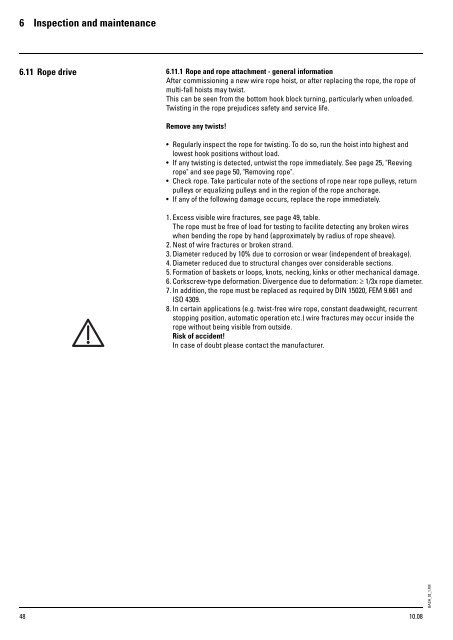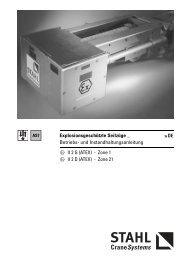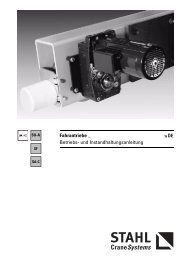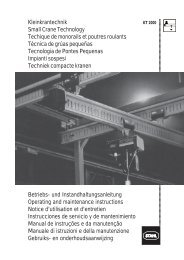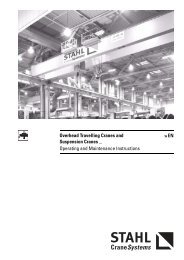Wire Rope Hoists _ Operating and Maintenance ... - STAHL-POLSKA
Wire Rope Hoists _ Operating and Maintenance ... - STAHL-POLSKA
Wire Rope Hoists _ Operating and Maintenance ... - STAHL-POLSKA
You also want an ePaper? Increase the reach of your titles
YUMPU automatically turns print PDFs into web optimized ePapers that Google loves.
6 Inspection <strong>and</strong> maintenance<br />
6.11 <strong>Rope</strong> drive<br />
48<br />
6.11.1 <strong>Rope</strong> <strong>and</strong> rope attachment - general information<br />
After commissioning a new wire rope hoist, or after replacing the rope, the rope of<br />
multi-fall hoists may twist.<br />
This can be seen from the bottom hook block turning, particularly when unloaded.<br />
Twisting in the rope prejudices safety <strong>and</strong> service life.<br />
Remove any twists!<br />
Regularly inspect the rope for twisting. To do so, run the hoist into highest <strong>and</strong><br />
lowest hook positions without load.<br />
If any twisting is detected, untwist the rope immediately. See page 25, "Reeving<br />
rope" <strong>and</strong> see page 50, "Removing rope".<br />
Check rope. Take particular note of the sections of rope near rope pulleys, return<br />
pulleys or equalizing pulleys <strong>and</strong> in the region of the rope anchorage.<br />
If any of the following damage occurs, replace the rope immediately.<br />
1. Excess visible wire fractures, see page 49, table.<br />
The rope must be free of load for testing to facilite detecting any broken wires<br />
when bending the rope by h<strong>and</strong> (approximately by radius of rope sheave).<br />
2. Nest of wire fractures or broken str<strong>and</strong>.<br />
3. Diameter reduced by 10% due to corrosion or wear (independent of breakage).<br />
4. Diameter reduced due to structural changes over considerable sections.<br />
5. Formation of baskets or loops, knots, necking, kinks or other mechanical damage.<br />
6. Corkscrew-type deformation. Divergence due to deformation: ≥ 1/3x rope diameter.<br />
7. In addition, the rope must be replaced as required by DIN 15020, FEM 9.661 <strong>and</strong><br />
ISO 4309.<br />
8. In certain applications (e.g. twist-free wire rope, constant deadweight, recurrent<br />
stopping position, automatic operation etc.) wire fractures may occur inside the<br />
rope without being visible from outside.<br />
Risk of accident!<br />
In case of doubt please contact the manufacturer.<br />
10.08<br />
BASH_02_1.FM


